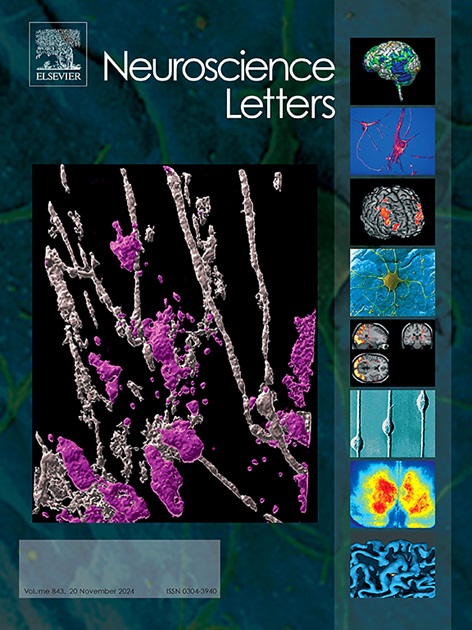Degree centrality alterations in different frequency bands in chronic insomnia: A resting-state fMRI study
IF 2.5
4区 医学
Q3 NEUROSCIENCES
引用次数: 0
Abstract
Purpose
Abnormal spontaneous neural activity in chronic insomnia (CI) has been identified in previous neuroimaging studies. However, whether the spontaneous neural activity is frequency-specific in CI is largely unknown.
Methods
We used resting-state functional magnetic resonance imaging (rs-fMRI) and degree centrality (DC) analysis to examine spontaneous neural activity in 37 CI patients and 20 healthy controls (HCs) across four frequency bands: slow-5 (0.012–0.031 Hz), slow-4 (0.031–0.081 Hz), slow-3 (0.081–0.224 Hz), and slow-2 (0.224–0.25 Hz). Partial correlation analysis was used to explore the relationship between abnormal DC values and clinical scales.
Results
In the slow-5 band, CI patients showed reduced DC in the occipital cortex compared with HCs. In the slow-4 band, CI patients displayed lower DC in the left middle temporal gyrus. In the slow-3 and slow-2 bands, decreased DC was primarily located in the frontal cortex. Moreover, CI patients showed higher DC in the right middle frontal gyrus and dorsolateral part of the superior frontal gyrus at the slow-4, slow-3, and slow-2 bands. Increased DC was also observed in the right median cingulate and paracingulate gyri at the slow-3 band. Furthermore, DC values in the right MFG at the slow-4 band were positively correlated with Mini-Mental State Examination scores.
Conclusion
Our findings suggest that CI patients exhibit widespread, frequency-specific alterations in brain activity, offering insights into the neurobiological mechanisms of CI.
慢性失眠症不同频带的度中心性改变:静息状态fMRI研究
目的在以往的神经影像学研究中发现了慢性失眠患者的神经自发活动异常。然而,自发性神经活动在CI中是否具有频率特异性在很大程度上是未知的。方法采用静息状态功能磁共振成像(rs-fMRI)和度中心性(DC)分析,检测了37例CI患者和20例健康对照(hc)在慢-5 (0.012-0.031 Hz)、慢-4 (0.031-0.081 Hz)、慢-3 (0.081-0.224 Hz)和慢-2 (0.224-0.25 Hz)四个频段的自发神经活动。采用偏相关分析探讨异常DC值与临床量表的关系。结果在慢-5波段,CI患者与hc患者相比枕皮质DC减少。在慢-4波段,CI患者在左侧颞中回显示较低的DC。在慢-3和慢-2波段,DC下降主要位于额叶皮层。此外,CI患者在慢-4、慢-3和慢-2波段表现出较高的右额中回和额上回背外侧部分DC。在慢-3波段右侧扣带中位和副扣带回也可见DC增高。此外,右侧MFG慢-4波段DC值与迷你精神状态考试分数呈正相关。我们的研究结果表明,CI患者在大脑活动中表现出广泛的、频率特异性的改变,为CI的神经生物学机制提供了新的见解。
本文章由计算机程序翻译,如有差异,请以英文原文为准。
求助全文
约1分钟内获得全文
求助全文
来源期刊

Neuroscience Letters
医学-神经科学
CiteScore
5.20
自引率
0.00%
发文量
408
审稿时长
50 days
期刊介绍:
Neuroscience Letters is devoted to the rapid publication of short, high-quality papers of interest to the broad community of neuroscientists. Only papers which will make a significant addition to the literature in the field will be published. Papers in all areas of neuroscience - molecular, cellular, developmental, systems, behavioral and cognitive, as well as computational - will be considered for publication. Submission of laboratory investigations that shed light on disease mechanisms is encouraged. Special Issues, edited by Guest Editors to cover new and rapidly-moving areas, will include invited mini-reviews. Occasional mini-reviews in especially timely areas will be considered for publication, without invitation, outside of Special Issues; these un-solicited mini-reviews can be submitted without invitation but must be of very high quality. Clinical studies will also be published if they provide new information about organization or actions of the nervous system, or provide new insights into the neurobiology of disease. NSL does not publish case reports.
 求助内容:
求助内容: 应助结果提醒方式:
应助结果提醒方式:


